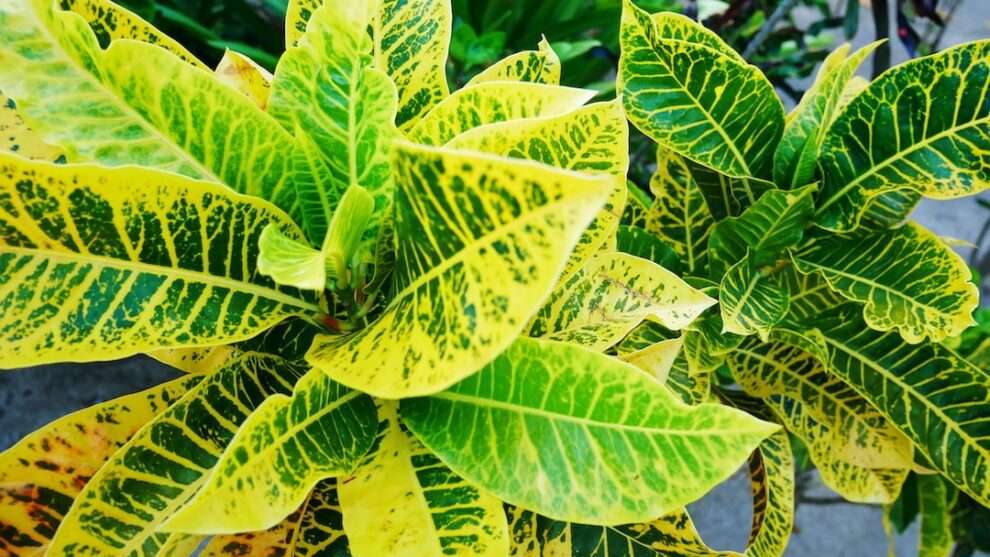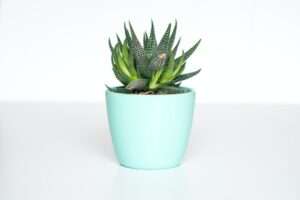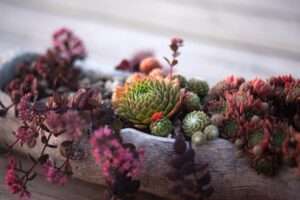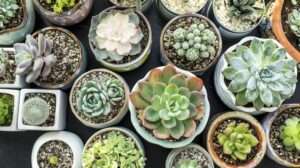Haworthias are a group of succulent plants that belong to the Asphodelaceae family. They are native to Southern Africa and were first discovered in the early 19th century by botanist Adrian Hardy Haworth, after whom they are named. These plants have become popular among succulent enthusiasts due to their unique characteristics and features.
Haworthias are known for their rosette-shaped leaves that grow in a spiral pattern. They have thick, fleshy leaves that store water, allowing them to survive in arid conditions. The leaves are often covered in small white tubercles or raised bumps, which give them a textured appearance. Some species also have translucent “windows” on their leaves, which allow light to penetrate and reach the chlorophyll-rich cells beneath.
The Diversity of Haworthias: A Wide Range of Shapes and Sizes
There are over 150 species of Haworthias, each with its own distinct characteristics. They vary in size, shape, and color, making them a diverse group of plants. Some species have long, slender leaves, while others have short, stubby leaves. Some have smooth leaves, while others have rough or textured surfaces.
One popular species is Haworthia attenuata, also known as the Zebra Plant. It has long, pointed leaves with white stripes that resemble zebra stripes. Another popular species is Haworthia cooperi, which has round, translucent leaves that form a tight cluster. Haworthia fasciata, also known as the Zebra Haworthia or Pearl Plant, has thick, triangular leaves with white tubercles.
Understanding the Unique Characteristics of Haworthias
Haworthias differ from other succulents in several ways. One key difference is their growth habit. While many succulents grow tall and upright, Haworthias tend to grow in a rosette shape, with their leaves forming a tight spiral. This growth habit allows them to maximize their exposure to sunlight while minimizing water loss.
The leaves of Haworthias play a crucial role in their survival. They are thick and fleshy, which allows them to store water during periods of drought. The tubercles or bumps on the leaves help to reflect sunlight and reduce the amount of heat absorbed by the plant. The “windows” on some species’ leaves allow light to reach the chlorophyll-rich cells beneath, enabling photosynthesis to occur even in low-light conditions.
Haworthias also have unique root systems. Their roots are shallow and fibrous, allowing them to quickly absorb water from the soil. They are also able to form symbiotic relationships with fungi, which help them absorb nutrients from the soil more efficiently.
The Beauty of Variegated Haworthias: Patterns and Colors
Variegation is a phenomenon where plants have different colored zones or patterns on their leaves. It can occur naturally or be induced through selective breeding. Variegated Haworthias are highly sought after by collectors due to their unique and striking appearance.
Variegation in Haworthias can take many forms. Some plants have white or cream-colored stripes or spots on their leaves, while others have yellow or pink variegation. The patterns can be symmetrical or random, adding to the visual interest of the plant.
One popular variegated Haworthia species is Haworthia limifolia ‘Variegata’. It has green leaves with white stripes that resemble the pattern of a spider’s web. Another popular variety is Haworthia cooperi ‘Variegata’, which has round, translucent leaves with white variegation.
Best Growing Conditions for Haworthias: Soil, Water, and Light
Haworthias thrive in well-draining soil that is specifically formulated for succulents. A mix of potting soil, perlite, and sand is ideal for providing the right balance of moisture retention and drainage. The pH level of the soil should be slightly acidic to neutral.
When it comes to watering, Haworthias prefer to be kept on the drier side. Overwatering can lead to root rot and other issues. It is best to water them thoroughly and then allow the soil to dry out completely before watering again. The frequency of watering will depend on factors such as temperature, humidity, and the size of the pot.
In terms of lighting, Haworthias prefer bright but indirect light. They can tolerate some direct sunlight, especially in the morning or late afternoon, but too much direct sun can cause their leaves to burn. Placing them near a window that receives filtered light or using a grow light can provide them with the optimal amount of light.
Propagating Haworthias: Techniques for Successful Reproduction

There are several methods of propagating Haworthias, including leaf cuttings, offsets, and seed propagation. Leaf cuttings involve removing a healthy leaf from the parent plant and allowing it to callus over before planting it in well-draining soil. Over time, new roots will develop from the base of the leaf, and a new plant will grow.
Offsets are small plants that grow from the base of the parent plant. They can be gently separated from the parent plant and planted in their own pots. This method is particularly useful for species that produce offsets readily.
Seed propagation involves collecting seeds from mature Haworthia plants and sowing them in a well-draining soil mix. The seeds should be kept moist but not overly wet until they germinate. This method requires patience, as it can take several months for the seeds to sprout.
Common Pests and Diseases of Haworthias: Prevention and Treatment
Haworthias are generally resistant to pests and diseases, but they can still be susceptible to certain issues. Common pests that can affect Haworthias include mealybugs, aphids, and spider mites. These pests can be controlled through regular inspection and the use of organic insecticides or insecticidal soaps.
Overwatering can lead to root rot, which is a common issue in Haworthias. To prevent root rot, it is important to ensure that the soil is well-draining and that the plant is not sitting in water for extended periods. If root rot does occur, it may be necessary to remove the affected parts of the plant and repot it in fresh soil.
Haworthias in Landscaping: Creative Ideas for Garden Design
Haworthias can be a unique addition to any garden or landscape design. Their compact size and low-growing habit make them suitable for rock gardens, succulent gardens, or container gardens. They can also be planted in between larger succulents or cacti to create a visually interesting contrast.
One creative idea for incorporating Haworthias into garden design is to create a “living wall” or vertical garden using a variety of succulents, including Haworthias. This can be done by attaching small pots or containers to a wall or fence and planting the succulents in them. The different colors and textures of the plants will create a stunning visual display.
Collecting Haworthias: Tips for Building a Unique and Valuable Collection
Collecting Haworthias can be a rewarding hobby for succulent enthusiasts. There are many rare and valuable species that are highly sought after by collectors. To start a Haworthia collection, it is important to do thorough research and learn about the different species and their care requirements.
One tip for finding rare and valuable Haworthia species is to join online forums or groups dedicated to succulent enthusiasts. These communities often have members who are knowledgeable about rare plants and may be able to provide tips on where to find them.
When collecting Haworthias, it is important to obtain them from reputable sources to ensure that they are healthy and disease-free. It is also important to practice responsible collecting and not remove plants from their natural habitats.
Haworthias in Culture and Art: Inspiration for Artists and Designers
Haworthias have inspired artists and designers in various ways. Their unique shapes, patterns, and colors make them a popular subject for botanical illustrations, paintings, and photography. They have also been used as motifs in textiles, ceramics, and other forms of art and design.
One way to incorporate Haworthias into creative projects is by using their leaves or rosettes as inspiration for patterns or designs. The spiral shape of their leaves can be used as a motif in fabric prints or as a design element in jewelry or accessories.
Conclusion: Recap of the unique characteristics and beauty of Haworthias, and how to care for and appreciate these fascinating succulents.
In conclusion, Haworthias are a fascinating group of succulent plants that have captured the attention of succulent enthusiasts around the world. Their unique characteristics, such as their rosette-shaped leaves, tubercles, and variegation, make them visually striking and highly sought after by collectors. Understanding their specific care requirements, such as well-draining soil, proper watering techniques, and optimal lighting conditions, is essential for their successful cultivation.
Whether used in garden design, incorporated into creative projects, or simply admired for their beauty, Haworthias are a versatile and captivating addition to any collection or landscape. With their wide range of shapes, sizes, and colors, there is a Haworthia species to suit every taste and style. So why not start your own collection of these fascinating succulents and discover the joy of caring for and appreciating these unique plants?
If you’re a succulent enthusiast, you’ll love this related article on GirlsGist.com: “Bringing the Outdoors In: How Indoor Succulents Can Transform Your Space.” Discover how these unique and variegated plants can add a touch of nature to your home decor. From choosing the right succulents for indoor environments to caring for them properly, this comprehensive guide will help you create a stunning indoor succulent display. Check out the article here and get ready to bring the beauty of nature indoors.
FAQs
What are Haworthias?
Haworthias are a genus of small succulent plants native to southern Africa. They are known for their unique and varied appearance, with many species featuring intricate patterns and markings on their leaves.
What makes Haworthias unique?
Haworthias are unique in their appearance, with many species featuring intricate patterns and markings on their leaves. They are also relatively easy to care for, making them a popular choice for indoor and outdoor gardens.
What are some popular Haworthia species?
Some popular Haworthia species include Haworthia fasciata, Haworthia cooperi, and Haworthia attenuata. Each species has its own unique appearance and care requirements.
How do I care for Haworthias?
Haworthias are relatively easy to care for and require minimal maintenance. They prefer bright, indirect sunlight and well-draining soil. They should be watered sparingly, allowing the soil to dry out completely between waterings.
Can Haworthias be grown indoors?
Yes, Haworthias can be grown indoors as long as they receive adequate sunlight and are planted in well-draining soil. They are a popular choice for indoor gardens due to their unique appearance and low maintenance requirements.
Are Haworthias toxic to pets?
Haworthias are generally considered non-toxic to pets, although ingestion may cause mild gastrointestinal upset. As with any plant, it is best to keep them out of reach of pets and children.

















Add Comment